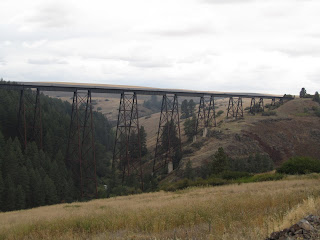







Back in Victoria where the autumn rains have had an early start, I thought I would be in a reflective mood about the parts of the United States I travelled through. Instead, all I wanted to do was sleep for a few days and vegetate in front of the TV, my mind a complete blank. The biggest problem with the trip was that it went by so fast. I have a friend from England who likes to point out that Europeans have no concept whatsoever of the sheer size of the American nation. Any country in Western Europe can be crossed by a fit cyclist in a few days. I nod in agreement only to discover I also did not comprehend the distances between the Pacific and the Atlantic coasts.
Not only are the distances vast, so are the differences among the regions. Areawise, Canada is even bigger than the US, but Canada is largely uninhabited. Only on the prairies do large population centres extend to the north, all the rest of the country strung along the southern border. Canada is what's left over to the north after the best and most productive parts of North America became the United States.
Which country has ten times the population of Canada. And whereas very little of Canada is populated to any degree, almost all of the lower 48 have thriving and diverse populations, many parts of which have long histories of settlement. While Canada is like a string of lights along the border, the US is like a doughnut. The most populous areas along the coasts and the Great Lakes, and a largely empty region in the middle, which only thrive because of works of hydraulics... rivers be dammed.
So the distance I experienced between Victoria and eastern Nebraska was of a greater magnitude than I imagined while contemplating the roads drawn in my maps. It was too much for me to absorb. Every area, to be properly experienced needs weeks at a minimum. Time is needed to meet people, to explore the byways, and get a feeling for it. Just watching the landscape flash by, even when I can keep the pace down to forty or fifty miles per hour, is absolutely insufficient.
Nevertheless, I'm glad I did it even if it just to learn that lesson. I also learned that I am a confirmed dweller by the sea. The wild and dry hills of Wyoming are beautiful, and so are the cornfields of Nebraska, but after a while I craved the sight of a green forest.
This November is shaping up to be a historic month in the US. It appears that a political sea change is taking place. For decades the elites in the cities and academies have imposed an alien rule on what is called Middle America. Middle America refers not just the people who occupy the middle regions of the country, but the productive classes in every part. While ordinary Americans have been busy 'doing the chores,' these elites have been undermining the foundations of the country. Now Middle America has had enough. A movement called the Tea Party has grown out of the American soil to take back their country from these usurpers. I rather wanted to be there for the Nov 2 elections but I will be watching and cheering from the sidelines.
But I would like to remind Americans that Canada went through something similar several years ago, when our arrogant governments tried to turn western Canadians into second class citizens. First we voted down a referendum on the matter, and then we virtually destroyed the party that sponsored the program. The Reform Party took its place, and unfortunately there were a bunch of pretenders, opportunists who saw an opportunity to jump on a bandwagon but who had no loyalty to the principals behind the Reform Party.
I'm sure the same thing will happen to the Tea Party, so keep your knives sharpened Tea Partyers. You will have to do some pruning after the first battle is won. But I think many Americans know that. They have paid for their freedom with their blood and I don't think they are going to roll over now.

































